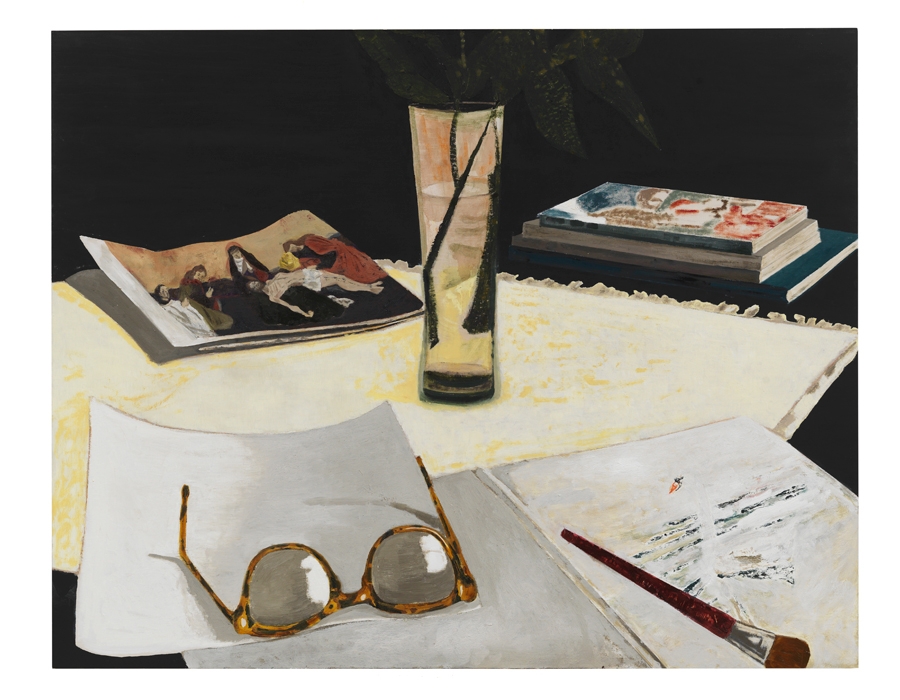Galleri Bo Bjerggaard, Copenhagen, 24 August – 22 October 2016
‘Letter writing is the only device for combining solitude with good company.’ Let us also apply Lord Byron’s aphorism to the present collaboration between Mamma Andersson and Tal R. Instead of letters, however, the painters exchanged source imagery – Polaroids and magazine cuttings – that each collects to aid their work. Initially this back-and-forth was accomplished through studio visits; later they corresponded by post, swapping further images. The solitude of the studio thus invaded, the act of painting expanded to become one of collaboration. The result of this artistic parlour-game is an exhibition in which visual motifs appear and reappear across a room of figurative and semifigurative sketches, a further two galleries of paintings and a corridorlike space in which four vitrines contain some of the source images and accompanying letters (a second show, with the same title, Svanesang, or ‘Swansong’, but composed only of paintings, runs concurrently at Galleri Magnus Karlsson, Stockholm).
Yet while the motifs are shared, Andersson and Tal R’s styles are very different, both in terms of painterly technique and, let us say, ‘emotional temperament’. Take, for example, a scene featuring a desk. A pair of reading glasses lies prominently next to a sketchpad and fine brush; a vase rests on the furthest edge between a pile of books and an image, a postcard perhaps, of Mary and her companions lamenting a crucified Christ. This is Andersson’s Påsk / Easter (all works 2016). Her use of pale colours in depicting the deskbound papers contrasts with the jet-black background, from which the dark green of the foliage in the vase is almost indistinguishable. In each quarter of the canvas, there’s a small flash of vibrancy amid this otherwise monochromatic wash: the tortoiseshell-framed spectacles at bottom left, the red-handled brush to bottom right, the blue and red books above, the red dress of one of the biblical figures. The same scene – almost – is painted by Tal R. His rusty autumnal palette, tinting the artist’s characteristically hard, well-defined and blocky forms, shows the desk, the glasses, the vase. The latter, however, contains a much brighter floral arrangement; moreover, Andersson’s sketchbook and fine brush morphs, in Tal R’s hands, into a notepad and pencil. And there’s no photograph of the Holy Mother and her son, though perhaps there is a smartphone in the bottom-right corner.

Tal R, Glassögon, 2016, pigment and rabbit glue on canvas, 175 × 203 cm. Courtesy Galleri Bo Bjerggaard, Copenhagen, and Galleri Magnus Karlsson, Stockholm
Swans are a recurring motif in both artists’ work (hence the exhibition title). The two waterbirds in Andersson’s Weekend face away from each other in a green lagoon: it’s a romantic scene – more black sky and murkiness – inviting melancholia while in front of it. In contrast Tal R eschews the immersive detailing of Andersson’s mode of painting. Consequently a work such as Svaner om natten (Swans at Night), almost ideogramlike in its figurative simplicity, is far quicker for the viewer to process. A dozen swan silhouettes, layered below what might be a group of out-of-proportion bulrushes and a row of boxy buildings to the top of the image, are deployed for Matissean patterning (which might either go towards figuration or abstraction) rather than realistic scene setting.
In bringing each other into their studios, Andersson and Tal R have invited us along to see, and compare, the mechanisms of their artmaking
All of this is a lesson in the nuts and bolts of painting, and in how both artists use real life as a starting point for something more beguiling. If this was all that was in play, however, the show might be a tad self-indulgent. In bringing each other into their studios, Andersson and Tal R have invited us along to see, and compare, the mechanisms of their artmaking. Founded on the assumption that we’re interested in seeing more than the finished works, this might be likened to an episode of Inside the Actor’s Studio (1994–), in which some Hollywood type waffles on about their ‘craft’ (when all we want, as director D.W. Griffith once noted, is a girl and a gun). Happily, however, Andersson and Tal R don’t let the image-exchange routine occupy the whole show: the duo leave the conceit in the vitrines and sketches, and move on from there. Each artist tackles images that the other doesn’t (or, as they noted in an accompanying catalogue interview, can’t: some imagery that worked for one was impossible for the other to do justice to, and duly abandoned). Tal R’s Deaf Institute, for example, a garden with tables in front of a municipal building, contains a floating eye in the middle of the work: a stroke of weirdness that Andersson, one feels, would never have made.
Likewise, one of the best, and simplest, works in the show is the latter’s Vintergatan / Blind Alley. It’s of a brooding empty urban space. A long shadow is cast across it from the tall buildings on the left. A series of doors with brick arches line this weedy street. Here is a painting that doesn’t need any conceptual embellishment: beautiful and sad, it just invites you to sit and look.
This article was first published in the October 2016 issue of ArtReview.
